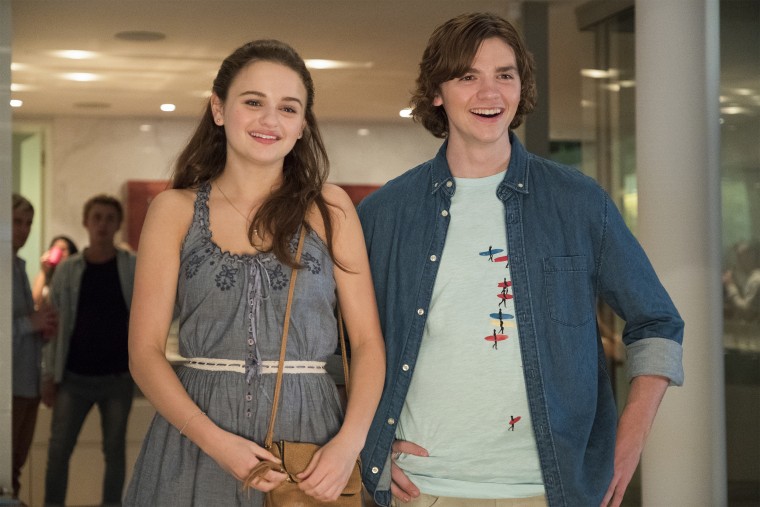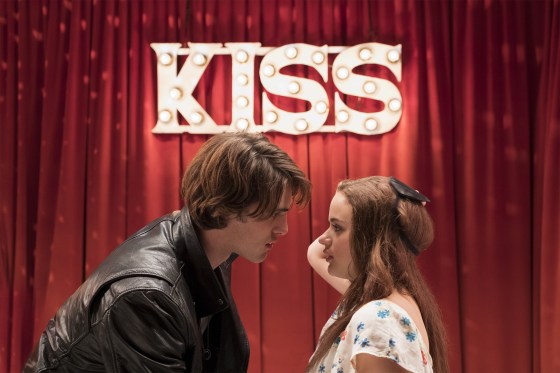Netflix’s “The Kissing Booth” arrived nearly two months ago on May 11, 2018. Based on the e-book of the same name, which was originally self-published on Wattpad by 15-year-old Welsh author Beth Reekles, the teen rom-com has become one of Netflix’s most popular offerings ever. According to Netflix’s numbers, one in three viewers of the film have re-watched it multiple times, making it a sleeper hit on par with such buzzy fare as “13 Reasons Why” or “Stranger Things.” And yet, the movie has been panned by the (few) critics who even know it exists. So who is fueling the demand? A perfect storm of Netflix audience demographics: rom-com lovers and teens.
The plot of “The Kissing Booth” is nothing special. In the vein of “Dawson’s Creek,” it’s about a girl torn between two men. In this case the two male leads are brothers, and only one is an actual love interest; the other is a platonic, childhood best friend. Hollywood-raised teen actress Joey King (“Ramona and Beezus”) plays heroine Elle, with Joel Courtney (“Super 8”) and newcomer Jacob Elordi playing the brothers she’s caught between.
The movie has been panned by the (few) critics who even know it exists. So who is fueling the demand? A perfect storm of Netflix audience demographics: rom-com lovers and teens.
The problem with the film — other than the problematic stereotyping of masculinity and relationships — is that it has no ideas of its own. It feels like it was written by someone who simply digested everything she was told "romance" was supposed to be by the patriarchy, and vomited back at us. Nearly every cliché in the film feels cribbed from another movie, like a song made completely of samples from better-known hits.
The throwaway plot says nothing new, and in that way, it is absolutely unchallenging to a teen audience who doesn't want to have to think about what they're watching. But that’s only part of what makes the film’s popularity so interesting. May was a big month for Netflix releases, with near daily new offerings, most of which contained at least one “Netflix Original.” From TV shows like “Unbreakable Kimmy Schmidt,” to comedy specials like “The Break with Michelle Wolf” to documentaries like Vox’s “Explained,” Netflix’s “something for everyone” philosophy was on full display.
On the same day “The Kissing Booth” premiered online, the service released no less than five original series, including the third installment of “Bill Nye Saves the World,” the fifth season of the cartoon “Spirit Riding Free” and the true crime documentary “Evil Genius: The True Story of America's Most Diabolical Bank Heist.” The last of those is probably the one most people have heard of, as it was the one Netflix chose to push to reviewers.
“The Kissing Booth” was definitely not something Netflix pushed out to the PR masses. As of the first week in July, Rotten Tomatoes shows only seven reviews of the film have come in, all of them uniformly dreadful. (It stands at 14 percent, which is pretty rotten.) The dearth of new romantic comedies helps explains some of this, although another Netflix rom-com, “Set It Up,” is a far superior example of the genre. But Netflix has also been executing a savvy (and apparently successful) push to attract a younger set of viewers to its platform.
More generally, Netflix has undergone an explosive growth spurt this past year. In the second quarter of 2017, its global active monthly users grew by 60 percent, fueled mostly via mobile apps. By the end of 2017, the service had surpassed all Wall Street expectations, with 117.6 million subscribers worldwide, 55 million of which were based here in the U.S. This subscriber boom has pushed Netflix to invest $2 billion into original content creation, which covers a broad swath of interests. It targets all kinds of audiences with algorithms based on individual viewing preferences.
Netflix has been executing a savvy (and apparently successful) push to attract a younger set of viewers to its platform.
On May 11, for example, my feed lead off with “Bill Nye Saves the World,” based on my habit of watching science documentaries, while my friend who loves true crime got “Evil Genius.” Meanwhile, those who showed a propensity for watching older rom-coms were presented with “The Kissing Booth.”
Netflix may have originally marketed itself to adults, but those adults have kids. Parents can make “viewer profiles” for their teen household members, both to monitor what their kids can watch, and also to keep kids shows out of their own algorithms. In doing so, these millions of households have given the service direct access to the teen market in a way movie studios only fantasize about.
Extrapolating from how Netflix bosses describe their process of offering shows to viewers, not only was “The Kissing Booth” most likely algorithmically pushed to appear at the tops of feeds for adults who watch rom-coms, chances are it also directly targeted teenage-oriented profiles. Which means that by mid-May, when the older of the target demos had finished college semesters, the younger crowd was just starting to slide into a predictable end-of-school apathy. The timing was perfect.
With Hollywood increasingly gravitating towards blockbusters reaching for the billion-dollar brass ring and prestige films aiming for Oscar gold, Netflix has found a lucrative niche.
We've seen this phenomenon before, in the success of “Riverdale,” for instance. The CW show was a so-so rating hit when it premiered in the spring of 2017 as a mid-season replacement. But a licensing deal with Netflix kicked in at the beginning of the year in which all of the CW’s new show immediately went to streaming a week after the finale aired. As a result, “Riverdale” debuted on Netflix on May 18, 2017, around the same time as the arrival of “The Kissing Booth” this year. "Riverdale" became a cult phenomenon over the summer, as teenagers and young 20-somethings binged it by the score.
The CW reaped the rewards too; the first season’s finale had 0.9 million viewers but the second season’s premiere recorded 2.3 million. And the show’s Live Ratings grew an unheard of 60 percent from the pilot to the second season’s premiere. Nearly all of this was due to teen interest, which was up an extraordinary 400 percent.

While many adults may look down on movies like “The Kissing Booth,” their success guarantees we’ll be seeing more midmarket rom-coms in our future. With Hollywood increasingly gravitating towards blockbusters reaching for the billion-dollar brass ring and prestige films aiming for Oscar gold, Netflix has found a lucrative niche.
For years, critics have wondered about the loss of this mid-tier movie market, which was historically made up of films not unlike “The Kissing Booth” promising only modest returns. For better or for worse, we now know where to find such movies. They’re on Netflix.
Ani Bundel has been blogging professionally since 2010. Regular bylines can be found at Elite Daily, WETA's TellyVisions, and Ani-Izzy.com.
